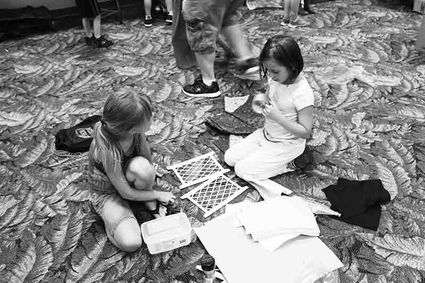Kids 'create and build' in Blaine County Library's summer reading program
June 15, 2016

Steve Edwards
Lori, left, and Rachel are shown with the raw materials they gathered to build a chicken coop..
Kelsey Harry, Blaine County Library's Assistant Librarian, is no stranger to putting together the library's summer reading programs for kids. For the prior summer's, she used a nationwide reading program put together specifically for libraries. This year Kelsey said, "I didn't really like the program that was available. There were several activities I've wanted to try but they never fit with the prepared program so this summer I decided to put together my own program. The summer program is all about creativity and building."
At the first session the attendees listened to a couple of books about fictional kids who were challenged to solve a problem. From the books they learned much about the creative process-especially that failures along the way force new approaches that can lead to a breakthrough solution to the problem.
The first challenge of this year's reading program was to create and build something unique using only contributed items that locals brought to the library. It was really a takeoff of the old story, "We bought the kids an expensive toy for Christmas and all they wanted to do was play with the box the toy came in."
Creating and building from trash
Kesley, with the help of locals, had collected a large amount of cardboard, sewing material, twine, empty plastic bottles, fuzzy decorating balls, popsicle sticks...well, the list went on and amounted to about half a pickup load of items all with potential for creating and building. Library Director Valerie Frank told that one future program attendee would come in regularly to inspect the cache of materials and show the library staff how various items could be made into something interesting or useful.
Around the room there were work tables with tools (hot glue guns, scissors, duct tape and other items) the builders could use. But first, they headed for the collection of items they could use for building. There is a saying about creativity that goes: "creativity is looking at something and seeing something different than what others see." That played out as kids pulled out all sorts of materials for their projects. It was hard to tell if an idea for the project drove the search for materials or if the sight of unique piece of building material inspired a project.
It was interesting how the kids worked-some worked best solo, others formed up into teams. Some liked the work stations where all the tools were handy, others sprawled on the floor and were less organized. Some appeared to have a very clear notion of what they were going to build and others seemed to kind of ease into an idea and let it develop as it flowed.
Two girls I observed, six-year old Rachel and seven-year old Lori, had been through the boxes of materials and had an odd looking collection of items for their project. They had opted to build on the floor and seemed to run to get glue or tape or whatever when they needed it rather than have it close at hand. They told me they were going to build a chicken coop. I asked, "Why a chicken coop?" They just shrugged. Hey, it's creativity and there's no explaining it.
The kids had about an hour to plan and build their projects. And the final products were pretty special, varying from the simple to the complex, the elegant to the rough, the obvious to the obscure. But every project showed something about the creative process. Later Library Director Valerie Frank said, "I thought the first session was a great success. The kids really got into the idea of creating and building something from what we would normally call trash. And a big bonus was no one got an 'owie' from the hot glue guns."
Library's and 'maker space'
Kelsey explained that much of the idea for the creativity-focused program came from a new trend gaining popularity in libraries. The 'maker space movement' began around 2006 as an outgrowth of the whole DYI movement (do it yourself movement). Libraries saw the role they could play in helping patrons experiment and learn new things. Some larger libraries added special rooms and technologies, like 3D printers and computer design programs, that allow users to create prototypes of ideas they have.
On a more modest level smaller libraries, like those in Blaine County, are part of the maker space movement, offering classes for adults to learn new skills, observe and try new crafts or hobbies and hear practitioners of creative activities describe what they do and how their interest-area works. And on a national basis, the whole maker space idea is being refined and tested as libraries create special spaces and tools for patrons to perfect their ideas. It's a trend that will likely be around for a while.
More info about summer reading programs in Blaine County
The libraries in Harlem and Chinook are both hosting summer reading programs and although both programs have started, kids can still begin at any time. The summer reading programs meet once a week and are geared to elementary students through grade six. Both libraries have other ongoing or age specific programa for younger kids and teens through adults. You can get more information by going to the libraries' websites: Harlem Public Library at http://www.harlempubliclibrary.org/ and the Blaine County Library in Chinook is http://www.blainecountylibrary.org/. Both libraries maintain a Facebook page where current information is available.


